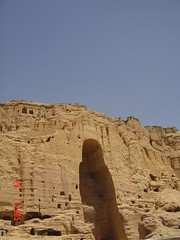What is the difference between a Buddha and an Arahant? Before “deciding” which way to go, lets hear what  the Buddha has to say on this topic:
the Buddha has to say on this topic:
At Savatthi… “Monks, the Tathagata — the worthy one, the fully enlightened one, who from disenchantment with form, from dispassion, from cessation, from lack of clinging (for form) is released — is termed ‘fully enligthened one.’ And a wisdom-liberated monk — who from disenchantment with form, from dispassion, from cessation, from lack of clinging (for form) is released — is termed ‘liberated by wisdom.’
“The Tathagata — the worthy one, the fully enlightened one, who from disenchantment with feeling … perception … fabrication, from dispassion, from cessation, from lack of clinging (for feeling … perception … fabrication… consciousness) is released — is termed ‘fully enlightened.’ And a wisdom liberated monk — who from disenchantment with feeling … perception … fabrication… consciousness, from dispassion, from cessation, from lack of clinging (for feeling … perception … fabrication) is released — is termed ‘liberated by wisdom’
“So what difference, what distinction, what distinguishing factor is there between one fully enlightened and a monk liberated by wisdom?
“For us, lord, the teachings have the Blessed One as their root, their guide, & their arbitrator. It would be good if the Blessed One himself would explicate the meaning of this statement. Having heard it from the Blessed One, the monks will remember it.”
“In that case, monks, listen & pay close attention. I will speak.”
“As you say, lord,” the monks responded.
The Blessed One said, “The Tathagata — the worthy one, the fully enlightened one — is the one who gives rise to the path (previously) unarisen, who engenders the path (previously) unengendered, who points out the path (previously) not pointed out. He knows the path, is expert in the path, is adept at the path.
And his disciples now keep following the path and afterwards become endowed with the path.
“This is the difference, this the distinction, this the distinguishing between one fully enlightened and a monk liberated by wisdom.” (SN 22.58)
This short sutta found in the Samyutta Nikaya directly contradicts one pillar of Mahayana philosophy, namely the idea that an Arahant is not finished in his spiritual development and that his attainment is not as complete or at least of an inferior quality as that of a Buddha.
In fact, this discourse by the Buddha shows that the path and the abilities of Arahants (those who follow the path pointed out to them and realize its goal) and Buddhas (those who in addition have to ‘discover’ the path by themselves before pointing it out to others) are different – yet the quality and completeness of the realization are the same!
If we read in the suttas even the concept of Arahants lacking compassion seems pretty narrow. Many circumstances are reported were we find the disciples of the Buddha showing compassion in teaching and sharing the Dhamma just like their teacher did. Following in the Buddha’s footsteps and passing on the information.
So, you could say, that the Buddha is an Arahant with the special ability of a master in teaching and a long re-collectable experience from which to draw. In fact, you probably even say that regularly, chanting: “iti pi so araham sammasambuddho…”
Here is another nice story in which the Buddha qualifies himself vice versa his students:
“It is just as if a man, traveling along a wilderness track, were to see an ancient path, an ancient road, traveled by people of former times. He would follow it. Following it, he would see an ancient city, an ancient capital inhabited by people of former times, complete with parks, groves, & ponds, walled, delightful. He would go to address the king or the king’s minister, saying, ‘Sire, you should know that while traveling along a wilderness track I saw an ancient path… I followed it… I saw an ancient city, an ancient capital… complete with parks, groves, & ponds, walled, delightful. Sire, rebuild that city!’ The king or king’s minister would rebuild the city, so that at a later date the city would become powerful, rich, & well-populated, fully grown & prosperous.
“In the same way I saw an ancient path, an ancient road, traveled by the fully enlightened Ones of former times. And what is that ancient path, that ancient road, traveled by the fully enlightened Ones of former times? Just this noble eightfold path: right view, right aspiration, right speech, right action, right livelihood, right effort, right mindfulness, right concentration. That is the ancient path, the ancient road, traveled by the fully enlightened Ones of former times. I followed that path. Following it, I came to direct knowledge of aging & death, direct knowledge of the origination of aging & death, direct knowledge of the cessation of aging & death, direct knowledge of the path leading to the cessation of aging & death. I followed that path. Following it, I came to direct knowledge of birth… becoming… clinging… craving… feeling… contact… the six sense media… name-&-form… consciousness, direct knowledge of the origination of consciousness, direct knowledge of the cessation of consciousness, direct knowledge of the path leading to the cessation of consciousness. I followed that path.
“Following it, I came to direct knowledge of fabrications, direct knowledge of the origination of fabrications, direct knowledge of the cessation of fabrications, direct knowledge of the path leading to the cessation of fabrications. Knowing that directly, I have revealed it to monks, nuns, male lay followers & female lay followers, so that this holy life has become powerful, rich, detailed, well-populated, wide-spread, proclaimed among celestial & human beings.” (SN 12.65)
 He had to break-through all by himself. However, contrary to Mahayana belief, in their realization of Nibbana there is no difference between an “Arahant” and a “Buddha”. How could there be a difference in the extinguishing of a candle and the extinguishing of an oil lamp. The fire has been put out (nibbana) and the fuel consumed (upadanakkhaya), the preparations silenced (sankharasamatho), all resting places given up (sabb’upadhi patinissagga).
He had to break-through all by himself. However, contrary to Mahayana belief, in their realization of Nibbana there is no difference between an “Arahant” and a “Buddha”. How could there be a difference in the extinguishing of a candle and the extinguishing of an oil lamp. The fire has been put out (nibbana) and the fuel consumed (upadanakkhaya), the preparations silenced (sankharasamatho), all resting places given up (sabb’upadhi patinissagga).
Monks, there are roots of trees, there are empty houses, concentrate, do not be negligent and repent later. This is our advice to you. (Sn 42.1)



